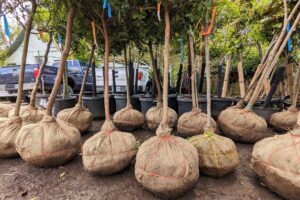Tag: urban forest
The Lifesaving Potential of Trees
A new scientific study associates tree planting with fewer deaths
At Friends of Trees, we champion the many benefits of urban trees: they clean the air and water, provide wildlife habitat, and shade our homes and streets. Trees improve our environment, but they also improve our quality of life. Dr. Geoffrey Donovan, a researcher with the United States Forest Service, wanted to investigate one step further — do trees save lives?
In 2013, Donovan conducted a study that associated a loss of trees from emerald ash borer with a higher rate of mortality for people that lived in those places that lost trees.
“I wanted to see if the inverse was true,” Donovan says. “Would planting more trees be associated with fewer deaths?”
Luckily, Donovan had access to years worth of tree planting data from Friends of Trees. Specifically, he used the planting data from the nearly 50,000 trees that Friends of Trees planted in Portland neighborhoods since 1990.
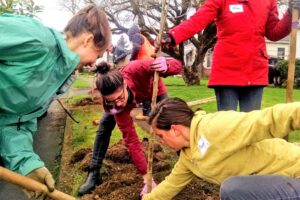
The new study, published in December 2022 in the journal Environmental International, found that each tree planted was associated with significant reductions in non-accidental and cardiovascular mortality. To account for other possible explanations for the mortality rate like race, education, and income, the statistical models incorporated data from the American Community Survey.
Looking at all 140 census tracts in Portland, Donovan showed that on average, 11.7 new trees in each neighborhood were associated with 15.6 fewer non-accidental deaths and five fewer cardiovascular deaths each year.
“It’s incredible,” says Friends of Trees Executive Director Yashar Vasef. “We know that trees can transform a community, but it’s really meaningful to see the data analysis.”
As the trees mature, their benefit grows too. Trees planted within the past 11-15 years had twice the impact of trees planted within the last five.
“The association is unequivocal, but the study has its limitations,” Donovan says. The study stops short of proving a definitive causal relationship between planting trees and fewer deaths, but Donovan expressed confidence in his findings, saying, “we do think it’s likely that trees are saving lives in Portland, because we accounted for a lot of other explanations.”
One way the study was able to account for other explanations was by focusing on the change in trees compared to the change in mortality rate. The totality of canopy can vary widely by neighborhood, but each new tree can make a difference regardless of where it’s planted.
The study went on to associate the reduced death rate with an incredible economic benefit, based on the EPA’s statistical value of a human life. Planting one tree in each of the 140 census tracts in Portland is associated with a reduction in non-accidental death of 1.33, which has a statistical value of $14.2 million. To plant and care for those 140 trees would cost just $3,000-$13,000.
“In short, trees are cheap and human lives are valuable,” Donovan says. “The public money that went to Friends of Trees generated remarkable rates of return.”
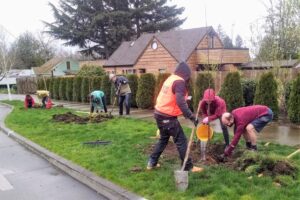
The City of Portland’s Bureau of Environmental Services did not renew its partnership with Friends of Trees that added 40,000 street and yard trees in Portland over 14 years. Friends of Trees is still planting in Northeast Portland as part of the Clean Air Canopy project, and in 17 municipalities throughout Western Oregon and Southwest Washington.
“Beyond the incredible findings, this study points to the importance of robust data collection,” Yashar says. “By diligently tracking this information, we are creating huge data sets that scientists can use in their research. And then that research can help us do our work better.” Friends of Trees logs the location, species, and planting date of every tree it plants.
“Friends of Trees data has been enormously helpful to me,” Donovan says. “I would love to see even closer collaboration between practitioners and scientists.”
Improving Air Quality in Eugene
How trees can help address winter inversions
Residents of Eugene and Springfield are very familiar with inversions. On a cold, clear winter day, pollutants get trapped in the valley, hanging low like a fog and causing notably poor air quality for people on the ground.
“On a cold, dry day, you can pretty much expect an inversion,” says Friends of Trees Eugene Director Erik Burke. “It’s not uncommon to see air quality alerts in winter.”
In the Eugene metro area, the main culprits are car emissions and wood smoke. Particulates in the air get trapped in the valley by warmer air above. It can lead to uncomfortable and even dangerous levels of air pollution. Because Eugene is at the southern end of the Willamette Valley and further away from winds coming from the Columbia River, it’s more susceptible to inversions than the Portland metro region.
One thing that can help? You guessed it, more trees! Trees improve air quality by providing surface area for airborne particulates to stick to. Those particulates are then washed by rain into the soil, where microorganisms break them down into something less harmful.
By breaking down pollutants, soil functions like a kidney of sorts. Trees help guide and slow water through the soil, making trees huge contributors to both air and water quality in both natural and urban environments. As Erik puts it, “trees are stormwater facilities.”
Like in plenty of other cities, the neighborhoods that are closest to polluters in Eugene are low income neighborhoods. Air quality is one of the many benefits of trees that low-canopy neighborhoods are deprived of. Friends of Trees plantings in the Bethel neighborhood are in part to address air quality concerns there.
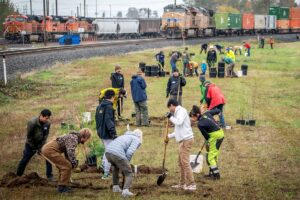
“All trees are good at improving air quality,” Erik says. “We’re trying to get trees in the ground where air quality is worst.”
This is one of the reasons Friends of Trees plants along the railyard and the Northwest Expressway, where idling locomotives and automobiles are releasing particulates.
While all trees improve air quality, evergreens are particularly useful because they keep their leaves or needles all year.
“Most of our rain comes in winter,” Erik says, “so evergreens are essential. We have a lot to learn about evergreens and air quality.”
Most of the evergreens in Eugene’s urban forest are conifers rather than broadleaf evergreens. While we often think of conifers when we think of evergreens, other species like California live oaks, holm oak and California bay laurel also keep their leaves year-round. Many evergreens grow to be quite large, so the Eugene team is looking to incorporate smaller evergreens like toyon into their plantings.
2010 Oregon Urban Forestry Conference: June 2-3
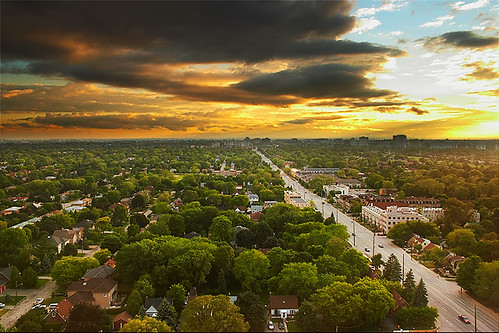
By Kris Day
The annual Oregon Urban Forestry Conference, this year titled Seed to City, will be taking place next week in Portland’s nursery-laden hinterlands on June 2 and 3. Covering a broad range of topics, this educational event should appeal to a wide range of associated professionals and interested community members. This year’s focus is on following the journey of an urban tree from its humble origins amongst thousands in a production nursery to its stately tenure as a member of an urban forest in a city near you.
Day one, at the J. Frank Schmidt & Son Nursery in Boring, Oregon, will be held in “the field” and will include nursery tours, demonstrations, and informative discussions on new trends and tree selections. Day two will take place at the Oregon Garden Resort in Silverton, Oregon, and will showcase new research on improvements in root development in nursery stock, the induced sterility of especially prolific trees (i.e. potentially invasive trees), and selective root and stem pruning that can lead to the increased health and stability of urban trees. Afternoon sessions will address the management of our urban forests with presentations on planting standards and citywide strategies for increased canopy development.
Events like this help to bring together a wide spectrum of opinion and expertise from different aspects of urban forestry. Here, where new ideas and experiences can be shared, new alliances may be made and existing ones further developed. To join in, visit the Oregon Community Trees website for daily agendas and to register.
Kris Day is a Neighborhood Trees Specialist with Friends of Trees.

